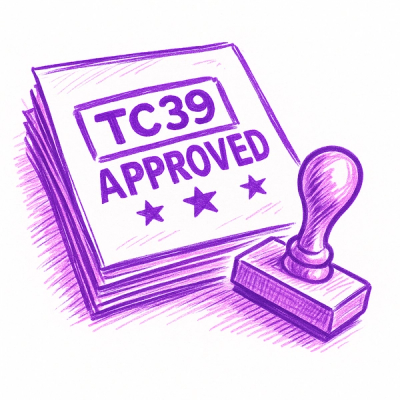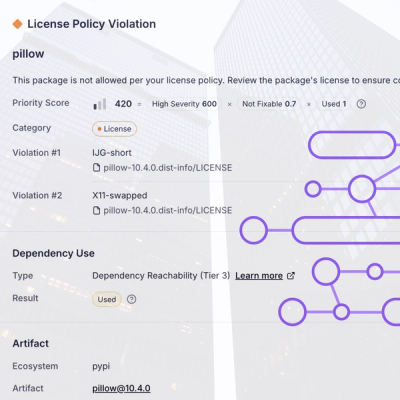
Security News
TC39 Advances 11 Proposals for Math Precision, Binary APIs, and More
TC39 advances 11 JavaScript proposals, with two moving to Stage 4, bringing better math, binary APIs, and more features one step closer to the ECMAScript spec.
quickblox-react-native-sdk
Advanced tools
See docs at https://docs.quickblox.com/docs/react-native-quick-start
This guide demonstarates how to connect quickblox-react-native-sdk to your project and start development.
QuickBlox application includes everything that brings messaging right into your application - chat, video calling, users, push notifications, etc. To create a QuickBlox application, follow the steps below:
To connect QuickBlox to your app just add it into your dependencies in package.json - to do so, in the root directory of the project execute the following command in terminal:
npm install quickblox-react-native-sdk --save
iOS and Android have different dependencies systems. For that reason, you need to install dependencies in your iOS project. Just locate ios/ folder in the root directory of the project and enter the following command in terminal:
pod install
Starting from v0.12.0, the SDK no longer manages permissions required for video calling functionality on Android.
If your app uses video calling, you must manually declare the necessary permissions in your app’s AndroidManifest.xml file.
Note: Ensure you're modifying the main
AndroidManifest.xmlfile at the application level, not a test or variant manifest.
<manifest xmlns:android="http://schemas.android.com/apk/res/android"
xmlns:tools="http://schemas.android.com/tools">
<!-- Permissions required for QuickBlox video calling functionality -->
<uses-permission android:name="android.permission.FOREGROUND_SERVICE" />
<uses-permission android:name="android.permission.FOREGROUND_SERVICE_CAMERA" />
<uses-permission android:name="android.permission.FOREGROUND_SERVICE_MICROPHONE" />
<!-- other manifest entries -->
</manifest>
Initialize the framework with your application credentials. Pass appId, authKey, authSecret, accountKey to the QB.settings.init method using the code snippet below. As a result, your application details are stored in the server database and can be subsequently identified on the server.
const appSettings = {
appId: "",
authKey: "",
authSecret: "",
accountKey: "",
apiEndpoint: "", // optional
chatEndpoint: "", // optional
};
QB.settings
.init(appSettings)
.then(function () {
// SDK initialized successfully
})
.catch(function (e) {
// Some error occured, look at the exception message for more details
});
In order to use the abilities of QuickBlox SDK, you need to authorize your app on the server, log in to your account and create a session. To get it all done call QB.auth.login method and pass login and password parameters to it using the code snippet below.
QB.auth
.login({
login: "yourlogin",
password: "yourpassword",
})
.then(function (info) {
// signed in successfully, handle info as necessary
// info.user - user information
// info.session - current session
})
.catch(function (e) {
// handle error
});
Note! You must initialize SDK before calling any methods through the SDK except for the method initializing your QuickBlox instance. If you attempt to call a method without connecting, the error is returned.
To connect to chat server, use the code snippet below:
QB.chat
.connect({
userId: 12345,
password: "passw0rd!",
})
.then(function () {
// connected successfully
})
.catch(function (e) {
// some error occurred
});
QuickBlox provides three types of dialogs: 1-1 dialog, group dialog, and public dialog. Learn more about dialogs here.
Let’s create 1-1 dialog. Call QB.chat.createDialog method and pass QB.chat.DIALOG_TYPE.CHAT parameter as a dialog type to it. QB.chat.DIALOG_TYPE.CHAT parameter allows specifying that two occupants are going to participate in the dialog.
QB.chat
.createDialog({
type: QB.chat.DIALOG_TYPE.CHAT,
occupantsIds: [12345],
})
.then(function (dialog) {
// handle as necessary
})
.catch(function (e) {
// handle error
});
To receive new messages, assign event handler using the code snippet below:
import { NativeEventEmitter } from "react-native";
const emitter = new NativeEventEmitter(QB.chat);
emitter.addListener(
QB.chat.EVENT_TYPE.MESSAGE.RECEIVED_NEW_MESSAGE,
(event) => {
const { type, payload } = event;
// type - type of the event (string)
// payload - new message (object)
}
);
When a dialog is created, a user can send a message. To create and send your first message, call QB.chat.sendMessage method and specify the dialogId and body parameters to it. Pass saveToHistory parameter if you want this message to be saved in chat history that is stored forever.
const message = {
dialogId: "dsfsd934329hjhkda98793j2",
body: "Hey there!",
saveToHistory: true,
};
QB.chat
.sendMessage(message)
.then(function () {
/* send successfully */
})
.catch(function (e) {
/* handle error */
});
For license information, please visit: https://quickblox.com/terms-of-use/
FAQs
QuickBlox SDK for React Native
The npm package quickblox-react-native-sdk receives a total of 171 weekly downloads. As such, quickblox-react-native-sdk popularity was classified as not popular.
We found that quickblox-react-native-sdk demonstrated a healthy version release cadence and project activity because the last version was released less than a year ago. It has 3 open source maintainers collaborating on the project.
Did you know?

Socket for GitHub automatically highlights issues in each pull request and monitors the health of all your open source dependencies. Discover the contents of your packages and block harmful activity before you install or update your dependencies.

Security News
TC39 advances 11 JavaScript proposals, with two moving to Stage 4, bringing better math, binary APIs, and more features one step closer to the ECMAScript spec.

Research
/Security News
A flawed sandbox in @nestjs/devtools-integration lets attackers run code on your machine via CSRF, leading to full Remote Code Execution (RCE).

Product
Customize license detection with Socket’s new license overlays: gain control, reduce noise, and handle edge cases with precision.